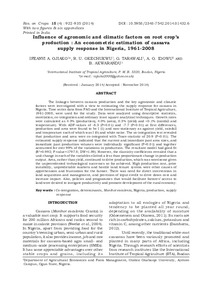| dc.contributor.author | Ojiako, I.A. |
| dc.contributor.author | Okechukwu, R.U. |
| dc.contributor.author | Tarawali, G. |
| dc.contributor.author | Idowu, A. O. |
| dc.contributor.author | Akwarandu, B. |
| dc.date.accessioned | 2019-12-04T11:03:28Z |
| dc.date.available | 2019-12-04T11:03:28Z |
| dc.date.issued | 2014 |
| dc.identifier.citation | Ojiako, I.A., Okechukwu, R., Tarawali, G., Idowu, A. & Akwarandu, B. (2014). Influence of agronomic and climatic factors on root crop's production: An econometric estimation of cassava supply response in Nigeria, 1961–2008. Research on Crops, 15(4), 922-935. |
| dc.identifier.issn | 0972-3226 |
| dc.identifier.uri | https://hdl.handle.net/20.500.12478/1090 |
| dc.description.abstract | The linkages between cassava production and the key agronomic and climatic factors were investigated with a view to estimating the supply response for cassava in Nigeria. Time series data from FAO and the International Institute of Tropical Agriculture, 1961–2008, were used for the study. Data were analyzed using descriptive statistics, correlation, co-integration and ordinary least square analytical techniques. Growth rates were calculated as 4.3% (production), 4.0% (area), 0.3% (yield) and <0.1% (rainfall and temperature). With ADF-values of -6.3 (P<0.01) and -7.7 (P<0.01) at first differences, production and area were found to be I (1) and non-stationary as against yield, rainfall and temperature each of which was I (0) and white noise. The co-integration test revealed that production and area were co-integrated with Trace-statistic of 20.9 (P<0.01). The estimated supply response indicated that the current and immediate past area sizes, and immediate past production volumes were individually significant (P<0.01) and together accounted for over 99% of the variations in production. The resultant model had good fit (R2=0.992; F-value=1797.8; DW=1.89). However, the elasticity coefficients revealed that a unit change in each of the variables elicited a less than proportionate change in production output. Area, rather than yield, continued to drive production, which was worrisome given the unprecedented technological successes so far achieved. High production cost, price instability, unpredictable markets and hostile land tenure system were other causes of apprehension and frustration for the farmer. There was need for direct intervention in land acquisition and management, and provision of input-credit to drive down cost and increase impact. Also, policies and programmes that would facilitate farmers’ access to land were desired to instigate productivity and promote development of the rural economy. |
| dc.language.iso | en |
| dc.subject | Integration |
| dc.subject | Manihot Esculenta |
| dc.subject | Production |
| dc.subject | Supply Response |
| dc.title | Influence of agronomic and climatic factors on root crops production: an econometric estimation of cassava supply response in Nigeria, 1961-2008 |
| dc.type | Journal Article |
| dc.description.version | Peer Review |
| cg.contributor.affiliation | International Institute of Tropical Agriculture |
| cg.contributor.affiliation | Olabisi Onabanjo University |
| cg.coverage.region | Africa |
| cg.coverage.region | West Africa |
| cg.coverage.country | Nigeria |
| cg.authorship.types | CGIAR and developing country institute |
| cg.iitasubject | Cassava |
| cg.journal | Research on Crops |
| cg.howpublished | Formally Published |
| cg.accessibilitystatus | Limited Access |
| local.dspaceid | 78088 |
| cg.identifier.doi | https://dx.doi.org/10.5958/2348-7542.2014.01432.6 |

